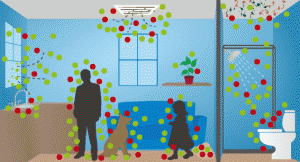I’m working on a manuscript where we analyze OTU co-occurrence patterns using network analyses as well as the traditional approaches (ordination, alpha diversity, etc.). This means that we have to include some equations in our methods and so for the first time, I am using Authorea and LaTeX. I am getting used to working with the …
Posting this which I received by email: Colleagues, We are thrilled to announce the launch of VERVE Net (https://www.protocols.io/g/verve-net), an on-line platform that equips the virus ecology community with a means to easily run, modify, publish and discuss laboratory, field and bioinformatic protocols. The forum also provides new ways to navigate the literature (a publication …
Last week I had the opportunity to present a lecture on the history of DNA sequencing in Jonathan Eisen’s EVE 161 Microbial Phylogenomics course. This lecture uses Elaine Mardis’ excellent review papers on the next generation sequencing methods as a guide (and required reading). You can see videos of both Dr. Mardis and Dr. Eisen presenting lectures on this topic. …
This month the QIIME development group is starting the transition from prototyping to developing QIIME 2. To mark this transition and to follow up on my recent blog post, Toward QIIME 2, I put together a demo video that illustrates the end point of one of our QIIME 2 prototypes, q2d2, which you can find …
I made a Storify summary of the Tweets from a workshop at the Pacific Symposium on Biocomputing that I attended on Tuesday on Computational Microbiology (with a big focus on microbiomes). [<a href="//storify.com/phylogenomics/psb16-session-on-microbiomes” target=”_blank”>View the story “#PSB16 session on computational microbiome #microbiomes ” on Storify]
Here are my notes from day 3 of the Mothur Workshop that is taught by Pat Schloss (pdschloss at gmail.com) at a hotel that is conveniently located near the Detroit airport. Of all of the bioinformatic workshops I have attended, this group of students was my favorite so far. We had a lot of fun …
Here are my notes from day 2 of the Mothur workshop taught by Pat Schloss (pdschloss at gmail.com) in December 2015. For those who are interested in learning to use Mothur for microbiome studies, Pat will be teaching another one in February. Mothur is better for bacterial characterization than eukaryotes because the sequences are aligned before OTU clustering. This …
Pat Schloss (pdschloss at gmail.com) offers excellent workshops on the Mothur software for analyzing 16S rRNA data for bacteria. He’s just announced the next one (February 8 to 10, 2016 near the Detroit airport). I had the pleasure of attending the December workshop. A diverse and international group attended the workshop, with many folks who are interested in the human microbiome. …
Source: Relative and contextual contribution of different sources to the composition and abundance of indoor air bacteria in residences | Microbiome | Full Text Another very useful paper from the Microbiome journal. This one from Marzia Miletto and Steven Lindow. Here is the Abstract: Abstract Background The study of the microbial communities in the built …
2013-5-19MBPF Source: Sources of airborne microorganisms in the built environment | Microbiome | Full Text Really nice new review paper by Aaron Prissin and Linsey Marr. It covers research on sources of airborne microbes including Humans Pets Plants Plumbing HVACs Water damage Dust Outdoor air Really thorough with tons of references and discussion of the …


